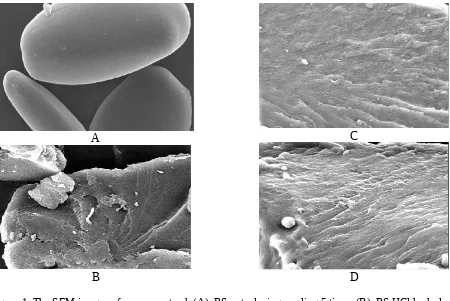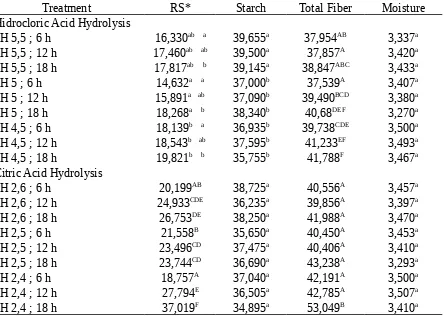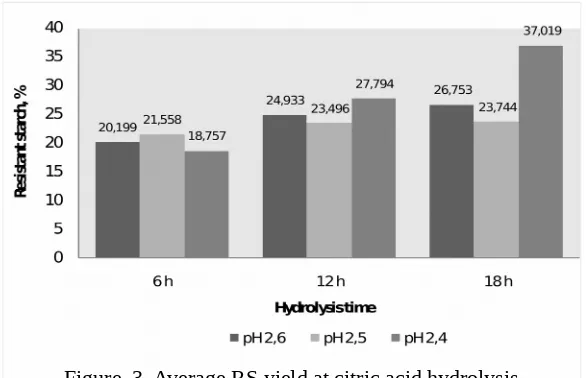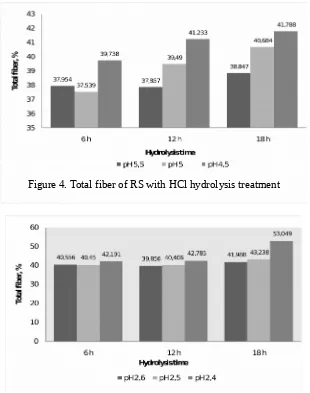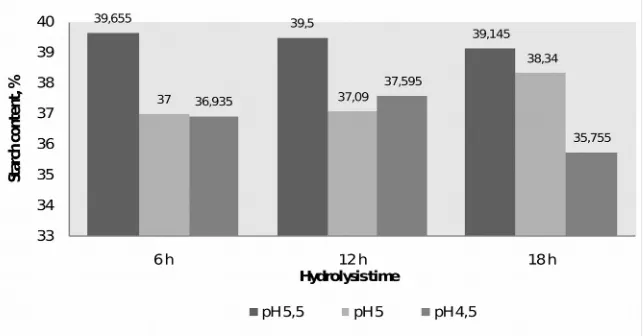GANYONG (
Canna edulis
Kerr) STARCH
Umi Rosidah1,*, Filli Pratama2, Kiki Yuliati3 and Basuni Hamzah4
Candidate of Ph.D, majoring in food processing, University of Sriwijaya, Indonesia
2 Professor, majoring in food chemistry, University of Sriwijaya, Indonesia 3 Ph.D, majoring in food management, University of Sriwijaya, Indonesia
4 Ph.D, majoring in food processing, University of Sriwijaya, Indonesia *Corresponding author : [email protected]
Abstract This research aimed to develop ganyong starch as resistant starch (RS) which has functional properties. Two kinds of acid hydrolysis (chloride acid and citric acid) on ganyong RS. Each hydrolysis was designed as Factorial Completely Randomized Design with two factors as treatments and each treatment was repeated three times. The first factor consisted of pH 5.5; 5 and 4.5 for the HCl hydrolysis; and pH 2.6; 2.5 and 2.4 for citric acid hydrolysis, whereas the second factor was the hydrolysis time (6, 12 and 18 hours). The parameters were the amount of RS and total fiber, starch and water content, as well as the micro structures of RS with SEM. The results showed that pH and hydrolysis time had significant effect on RS, fiber, and starch but had no significant effect on water content. The starch content in the RS was affected by pH level for both HCl and citric acid hydrolysis. The SEM showed that the RS processed by citric acid was more condensed compared to HCl. The highest RS (37.019%) and fiber (53.04%) content was obtained by citric acid hydrolysis at the pH of 2.4 for 18 hours of hydrolysis, and the water content was 3.27% to 3.51%.
Keywords ganyong, resistant starch, chloride acid, citric acid, hydrolysis
1. Introduction
Research over the last few decades has found that a significant portion (about 10%) is not digested in the small intestine and passes into the large intestine where it is a substrate for bacterial fermentation. This starch is called resistant starch (RS) and many nutritionists think that it should be classified as a component of dietary fibre. Resistant starch represents retrograded starch. Thus, in the formation of resistant starch the starch granule is completely hydrated. Amylose leaches from the granules into the solution as a random coil polymer. Upon cooling, the polymer chains begin to reassociate as double helices, stabilized by hydrogen bonds [1].
Resistant starch positively influences the functioning of the digestive tract, microbial flora, the blood cholesterol level, the glycemic index and assists in the control of diabetes. Apart from the potential health benefits of resistant starch, another positive advantage is its lower impact on the sensory properties of food compared with traditional sources of fibre, as whole grains, fruits or bran [10].
Resistant starch can be formed through retrogradation. Retrogradation is the precipitation of starch molecules in cooled pastes and gels that contain mainly amylose. The hydrogen bonds within hydrated starch interact and result in physical-chemical changes. Amylopectin retrogrades very slowly. The higher the amylose content is, the greater the retrogradation. It is also found that high amylose starch is more resistant to digestion than amylopectin due to its compact linear structure [2]. Factors that determine rate of retrogradation are molecular ratio of amylose to amylopectin, structures of the amylose and amylopectin, temperature, starch concentration, presence and amount of other ingredients, e.g., sugars [3].
Retrograded amylose, also known as resistant starch type III, could be formed from native starch granules that have been gelatinized and retrograded afterwards [4]. Depending on amylose concentrations, amylose upon storage may aggregate or gel. At less than 1.5%, amylose solutions would aggregate and have crystalline double helices of approximately 10 nm interspersed in
amorphous regions. According to Miles et al, amylose solutions with concentrations greater than 1.5 % would form amylose gels [5]. There are two steps involved: phase separation so that a continuous network of polymer-rich phase forms and the second step has double helices formation in the polymer-rich phase and on aging these helices would aggregate to form three-dimensional crystalline structures. Retrograded amylose is thermally very stable. Comparing with heating treatment , during treatment of starch with HCl and citric acid, the gelatinized starch is easier to be hydrolized. Amylopectin might be hydrolized by acid to form linear starch molecules, like amylose. Acid treatment of retrograded starch therefore would lead to the increase of RS yield.
Like dietary fiber, resistant starch is not digested in the small intestine but can be fermented in the large intestine. A number of studies indicate that both resistant starch and dietary fiber produce short chain fatty acid (SCFA) metabolites, lower colonic pH, decrease intestinal transit time, and increase fecal bulk [6]. When resistant starch escapes digestion, it becomes a significant proportion of the carbohydrates that will be metabolized by bacteria in the colon. As microorganisms in the colon ferment undigested carbohydrates, SCFA, including acetate, propionate, and butyrate, are released lowering colonic pH. Compared to dietary fiber, resistant starch produces a higher proportion of butyrate, which is believed to be consistent with good colonic health [7].
Ganyong (Canna edulis Kerr) is a local potential starch from Indonesia. Ganyong starch is used for many purposes (cookies, soun, and baby food). For this potential, ganyong starch is used in our study to prepare RS through autoclaving-cooling cycles and continued with HCl and citric acid hydrolysis. The objective of our study was to determine the effect of HCl and and citric acid hydrolysis of retrograded ganyong starch on RS formation.
2. Materials and methods
2.1. Materials
Ganyong starch was obtained from Bantul, Central Java, Indonesia. Amylase from bacillus amyloliquefacients Cat. A 7595 Sigma Aldrich, amyloglucosidase from aspergillus nigia Cat. A 7420 Sigma Aldrich, and protease from aspergillus soitol Cat. P 2143 Sigma Aldrich. Other chemicals used were analytical agents
2.2. Preparations of RS
2.2.1. Autoclaving-cooling cycle of ganyong starch.
Ganyong starch (20% w/v) was heated and stirred at 700C, 15 minutes. The mixture was
pressure-cooked in an autoclave at 1100C, 1200C, 1300C (treatment) for 30, 60, 90 min (treatment) in 3, 4, 5
(treatment) autoclaving-cooling cycles (40C for 24 hours), then dried in an oven (500C for 24 h) and
ground into fine particles. Each preparation was carried in triplicate. 2.2.2. HCl hydrolysis of ganyong retrograded starch
Retrograded ganyong starch prepared through five autoclaving-cooling cycles at 1300C for 90
minutes was dispersed in distilled water in a ratio of 1:4. Some HCl was added until pH 5,5 5 and 4,5 (treatment) at room temperature for 6, 12 and 18 hours (treatment). Sodium hydroxide solution was added to neutralize acid untuil pH 7 and dried in an oven (500C for 24 h) and ground into fine
particles. Each preparation was carried in triplicate. 2.2.3. HCl hydrolysis of ganyong retrograded starch
Retrograded ganyong starch prepared through five autoclaving-cooling cycles at 1300C for 90
minutes was dispersed in distilled water in a ratio of 1:4. Some citric acid was added until pH 2,4, 2,5 and 2,6 (treatment) at room temperature for 6, 12 and 18 hours (treatment). Lime solution was added to neutralize acid until pH 7 and dried in an oven (500C for 24 h) and ground into fine
particles. Each preparation was carried in triplicate.
2.3. Analysis of ganyong starch
The ganyong raw starch was determined by proximate analysis.
2.4. Determination of RS
RS content in all samples were determined with enzymatic gravimetric method by AOAC with modifications. The main procedures is following: 0,5 g of RS sample was diluted in 25 mL buffer phosphate 0,08 M (pH 6) in 250 ml glass and incubated with 0,2 ml amylase at 600C for 30 minutes
and strirred gently every 5 minutes. Samples was cooled at room temperature, added 0,275 N HCl until pH 4,5. Samples was incubated with 30 µL amyloglucosidase at 400C for 16 hours with constant shaking to hydrolyze digestible starch. pH adjusted to 7,5 with added 0,325 N NaOH and incubated with 50 µL protease (40 mg protease /50 mL buffer phospahe, pH 6,0) with constant shaking at 600C for 30 minutes. Samples was centrifugated at 3000 rpm for 10 minues, pick residual
up with paper saring, and washed twice with 80% ethanol dan water distillation. Residue is heated in oven at 400C. RS = (residual weight/ sample weight) x 100%.
Total fiber of ganyong RS determined with Van Soest fiber analysis. Starch content determined with direct acid hydrolysis method and water content determined with oven method. RS image determined with SEM (Scanning Electron Microscope) JEOL JSM 5310 LV Japan.
2.5. Statistical analysis
All data were expressed as means ± SE from at two and three indpendent trial. Differences between the mean values of multiple groups were analyzed by one-way analysis of variance (ANOVA).
III. Results and discussions
3.1. Composition of ganyong starch
The composition of ganyong starch shown in Table 1. The proximate analysis showed that ganyong starch is still available compared with wheat flour. Table 2 show the composition of dietary fiber of ganyong starch.
Table 1. Composition of ganyong starch compared with wheat flour.
No Composition (%) Ganyong starch Wheat flour
1 Carbohydrat 89,43 74,28
Table 2. Composition of dietary fiber of ganyong starch
No Composition %
1 Hemicellulose 0,88
2 Cellulose 90,26
3 Lignin 0,05
4 Pectine 0,50
Total 1,72
3.2. Morphological characteristics of ganyong starch and resistant starch by SEM
A
B
C
D
Figure 1. The SEM images of ganyong starch (A), RS autoclaving-cooling 5 times (B), RS HCl hydrolysis (C), and RS citric acid hydrolysis (D)
The SEM images of ganyong resistant starch samples were obtained and compared with that of ganyong starch. Figure 1 clearly illustrated that the modification ganyong starch by autoclaving-cooling altered the starch structure, while native starch exhibited a granular appearance (1A), the granular structure disappeared and a continuous network with irregular shape was formed in the physically resistant starch (Fig. 1B). On the other hand, the use hydrocloric acid appeared to make the resistant starch texture compact and dense (Fig 1C) but the best one was shown by citric acid hydrolysis (Fig. 1D). In this image shows that surface of RS become more compact and dense. From SEM images seemed that textural changes become apparent. These changes were attributed to interplay of factors such as: (1) amylose content, (2) interactions between starch chains, and(3) arrangement of amylose chains within the amorphous domains.
3.3 Result of resistant starch and chemical analysis
The result of treatment of ganyong starch on RS level can be seen at Table 4. RS obtained was analyzed and the results can be seen at Table 4 that shows the RS, starch, total fiber and moisture level of each treatments.
The measurement results calculated by statistical analysis of variance ANOVA with a level of accuracy of 95% and 99%. The calculations show that the treatment pH and time of hydrolysis was
significant to very sifnificant on RS, total starch and total fiber, while the moisture content is not significant.
Table 3. Result of RS level and chemical analysis of RS on each treatment
Treatment RS* Starch Total Fiber Moisture
Values followed by the same letter are not significantly different (a= P<0,05 and A= P<0,01)
*Value of RS in the treatment HCl hydrolysis had significant effect on treatment and treatment interaction was not significant. The left letter leads to the treatment of pH and the right letter leads to a time of hydrolysis treatment.
3.3.1. Resistant starch level through HCL and citric acid hydrolysis
Resistant starch was produced by two steps: gelatinization and retrogradation. Starch granule swelling is known to begin in the bulk relatively mobile amorphous fraction and in the more restrained amorphous regions immediately adjacent to the crystalline region [8]. It seems that RS is disintegrated through autoclaving and then recrystallized by association between linear amyloses or between amylose and amylopectin through cooling.
When ganyong starch was treated with 5 autoclaving-cooling cycles at 1300C for 90 minute and
retrograded starch obtained was hydrolized with hydrocloric acid and citric acid, the effect of acid hydrolysis on RS yield were shown in Fig. 2 and Fig 3.
From Fig 2 and 3 we can see that hydrolysis time and pH have significant effect on RS yield. Compare to RS with hydrolyzed hidrocloric acid, treatment of retrograded starch with citric acid pH 2,4 have a clear effect on RS yield. The best yield of RS, that was 37,019%, was reached by citric acid hydrolysis pH 2,4 at room temperature for 18 hours. This result indicated that hydrolysis of retrograded starch with citric acid would more beneficial to RS formation than that with hydrocloric acid.
Figure. 2. Average RS yield at HCl hydrolysis
Figure. 3. Average RS yield at citric acid hydrolysis
Mun and Shin (2006) explained that the hydrolysis of maize starch with 0,1 M HCl for 0,25 – 30 days showed that RS gradually increases from 14,9% – 25,9% [9]. The yields of RS of this research are comparable with those of Zao and Lin (2009) that research about the effect of acid hydrolysis on RS yielded [11]. They reported that when retrograded high amylose maize starch was hydrolyzed with 0,1 mol L-1 hydrocloric acid or acetic acid the RS yield is 29,2% and 30,0%. While treatment
of retrograded high amylose maize starch with 0,1 mol L-1 citric acid did have 39% RS yield.
3.3.2. Total Fiber Starch Level through HCL and citric acid hydrolysis
Resistant starch is unique because although starch, resistant starch when analyzed showed itself as a total dietary fiber (TDF). Although not a cell wall component, RS is obviously nutritionally more similar to NSP than to digestible starch. There is ample justification that RS behaves physiologically like fiber. RS assays as insoluble fiber, but has the physiological benefits of soluble fiber [1].
Total fiber produced from this study show that the lower the pH and the longer time of hydrolysis showed a higher yield Fig. 4 and Fig. 5. These results are consistent with the values RS that obtained from this study. According to Sajilata et al (2006) RS values measured as insoluble fiber on the measurement of fiber [1].
At HCl hydrolysis seen that the value of total fiber ranged from 37.539% - 41.788%. At citric acid hydrolysis seen that the value of total fiber ranged from 39.836% - 53.049%. The content of dietary fiber in the starch can be increased to 3.5 to 4 times through the modification of starch. This is
confirmed by research Ranhotra et al. (1991) in the Sajilata et al. (2006) that the treatment of recurrent cycles of autoclaving-cooling can increase the total dietary fiber content of 3 to 4-fold [1]. Elevated levels of total dietary fiber exposed to increased levels of resistant starch measured as insoluble fiber.
Figure 4. Total fiber of RS with HCl hydrolysis treatment
Figure 5. Total fiber of RS with citric acid hydrolysis treatment
3.3.3. Starch level through HCL and citric acid hydrolysis
Measurement of total starch of RS produced shows that the longer time of hydrolysis and the smaller the pH, the total starch were measured become smaller. This is due to the existing starch has been turned into resistant starch. HCl and citric acid hydrolysis gave different results, where citric acid hydrolysis gives a smaller yield than HCl hydrolysis.
From Figure 6 and 7 shows that citric acid hydrolysis gives better results than HCl hydrolysis. Starch left shows a value of 34.895% in the treatment of pH 2.4 and hydrolysis time 18 hours.
Figure 6. Starch value (%)of RS with HCl hydrolysis treatment
Figure 7. Starch value (%)of RS with citric acid hydrolysis treatment
3.3.4. Moisture level through HCL and citric acid hydrolysis
Moisture content in RS was not statistically different. This result was consistance with operations in this research where starch was dried at same time and temperature. This result also showed that the treatment of this research not affected in moisture content. The moisture of RS have value between 3,270% – 3,507%.
4. Conclusion
RS could be prepared from ganyong starch through 5 autoclaving-cooling cycles and citric acid hydrolisis pH 2,4 for 18 hours at room temperature with RS yield up to 37,019 %. Hydrolisis of retrograded ganyong starch with diluted citric acid was better than hidrocloric acid.
Acknowledgement
The authors wish to thank the members of Agriculture Faculty, Sriwijaya University for their technical support on providing laboratory studies. This work was supported by BPPS Grant from Ministry of National Education.
References
[1] Sajilata, M.G., Rekha S.Singhai, and Puspha R. Kulkarni. 2006. Resistant starch-A review. Comprehensive reviews in food science and food safety. Vol. 5.2006.
[2] Rashmi, S. and Urooj Asna. 2003. Effect of processing on nutritionally important starch fractions in rice varieties. International Journal of Food Sciences and Nutrition 54:27-36. [3] Fennema, Owen R (Ed.). 3rd ed. 1996. Food Chemistry. Ch. 4 in Carbohydrates. P. 167- 168,
[4] Eerlingen, R.C, Cillen, G., and Delcour, J,A. 1994. Enzyme-resistant starch. IV. Effect of endogenous lipids and added sodium dodecyl sulfate on formation of resistant starch. Cereal Chem. 71(2):170-177.
[5] Miles M.J, Morris V.J. Orford P.D. and Ring S.G. 1985. Recent observations on starch retrogradation. In New Approaches to Research on Cereal Carbohydrates, ed. R.D. Hill and L. Munck. Amsterdam: Elsevier Science Publishers.
[6] Gordon, DT, Topp, K, Shi, Y-C, Zallie, J & Jeffcoat, R. 1997. Resistant starch: physical andphysiological properties. In Yalpani, M. (ed). New Technologies for Healthy Foods &Nutraceuticals. ATL Press, Inc. Science Publishers, Shrewsbury, MA: 157-178.
[7] Baghurst, PA, Baghurst, KI & Record, SJ. 1996. Dietary fiber, non-starch polysaccharides and resistant starch -- a review. Food Aust. 48(3):S3-S35.
[8] Donovan J.W., Phase transitions of starch-water system. Biopolymers, 1979, 8, 263–275. [9] Mun, Sae Hun and Malshick Shin . Mild hydrolysis of resistant starch from maize Food
Chemistry 96 (2006) 115–121. 2006.
[10]Zaragoza, E. Fuentes, M.J. Riquelme-Navarrete, E. Sánchez-Zapata, and J.A. Pérez-Álvarez. 2010. Resistant starch as functional ingredient: A review. Food Research International. Volume 43, Issue 4, May 2010, Pages 931–942
[11] Zhao, Xin-Huai and Yang Lin. 2009. Resistant starch prepared from high-amylose maize starch with citric acid hydrolysis and its simulated fermentation in vitro. European Food Research and Technolgy Volume 228, Issue 6, pp 1015-1021.
